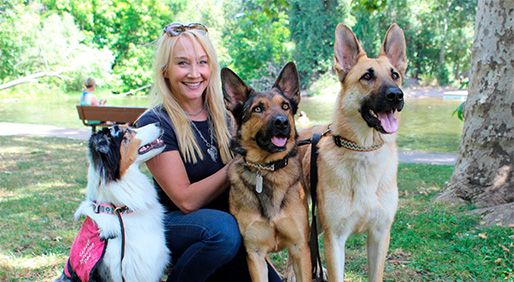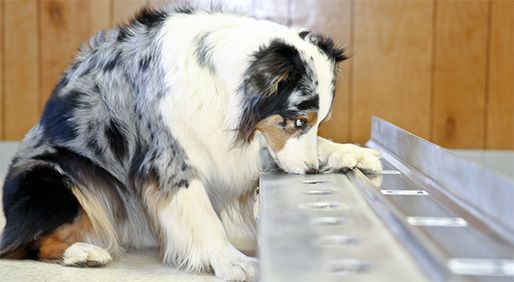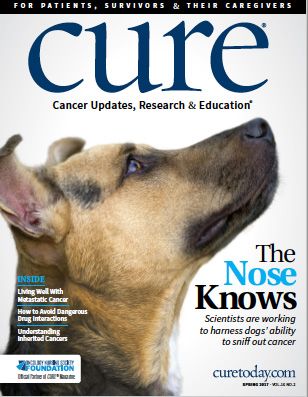The Nose Knows: Can Dogs Be Trained to Sniff Out Cancer?
Scientists are working to harness dogs’ ability to sniff out cancer.
DINA ZAPHIRIS, founder and CEO of the In Situ Foundation — which trains dogs to sniff out cancer — poses with (from left) Stewie, Linus and Leo. Among them, the dogs have the ability to detect breast, lung, ovarian and orolaryngeal cancers. - COURTESY DINA ZAPHIRIS

DINA ZAPHIRIS, founder and CEO of the In Situ Foundation — which trains dogs to sniff out cancer — poses with (from left) Stewie, Linus and Leo. Among them, the dogs have the ability to detect breast, lung, ovarian and orolaryngeal cancers. - COURTESY DINA ZAPHIRIS
When it comes to detecting cancer, our dogs appear to have much keener senses than we do.
Take the special-needs teacher in Kent, England, who in 2015 noticed that her German shepherd, Inca, had become unusually interested in smelling her breath. She went to the doctor for a check-up and found out she had lung cancer. Because of the dog, she believes, it was diagnosed early, at stage 1.
The same year, a 40-year-old Rochester, Minnesota, woman was studying for a university test when her golden retriever-St. Bernard mix started nosing at her left side and acting crazy. When she went to brush away the dog slobber, she felt a lump. She was later diagnosed with breast cancer.
Actress Shannen Doherty — famous for her roles in the TV show "Beverly Hills 90210" and the movie "Heathers" — reported a similar experience with her German shepherd Bowie; now, she’s undergoing treatment for breast cancer.
Google “My dog detected my cancer” and you’ll find dozens of similar anecdotes, from all over the world. In fact, anecdotes about such occurrences go back decades. There's no proof that any of these pet dogs, untrained in cancer detection, truly found the disease. Still, what was once just fun material for tabloids or an offbeat research topic is now beginning to gain a toehold in the mainstream, with research teams and nonprofit organizations gnawing at the problem worldwide.
These are very early days for peer-reviewed research, but studies have established that some dogs, after intensive training, can indeed detect many types of cancer — breast, ovarian, lung, prostate, thyroid, colorectal, melanoma — from a variety of biological samples, including breath, urine, plasma and blood.
The daunting challenge now is to replicate those studies. Then, scientists must figure out how to translate dogs’ diagnostic skill into clinically useful, standardized protocols that can be scaled up from study samples of a few dozens or hundreds to the millions who are screened for cancer each year.
“We can do it,” says Dina Zaphiris, a dog trainer and CEO of the In Situ Foundation, a Chico, California-based nonprofit organization dedicated to training cancer-sniffing dogs. “We’ve trained our dogs to be 90 percent accurate in sensitivity (detecting the cancer) and specificity (not alerting to false positives). They’re doing what machines can’t do.”
Why would scientists take a chance on an animal that can, like any living being, be unpredictable?
It’s because a dog’s sense of smell is so profound that it’s like a superpower: Dogs have approximately 300 million odor receptors, compared with 6 million, at best, in humans. They also have a second smelling apparatus, the “vomeronasal organ,” a patch of sensory cells near the back of their nasal cavity that’s dedicated to detecting pheromones, moisture-borne odor particles unique to each species that carry signals such as sexual readiness. A dog’s anatomy allows it to sniff pretty much continuously, separating air into one stream for respiration and into another stream for smelling. Proportionally, the section of a dog’s brain devoted to analyzing smells is 40 times larger than that section in humans. Estimates vary, but scientists think that a dog’s sense of smell may be 10,000 to 100,000 times better than ours.
It’s difficult to wrap your mind around a sense that powerful. We humans live in a vision-dominated reality. To translate the difference in smelling power into visual terms, imagine that we humans can only perceive light and dark in two dimensions through a pinhole while dogs see thousands of shapes and shades in 3-D Technicolor. Scientists also like to use this vision analogy: It’s as if we can see a third of a mile away, while dogs can see 3,000 miles away.
Add to this that current methods of cancer detection, alas, are often hit-or-miss. In many cases, symptoms don’t appear until the disease is in late stages. And many types of cancer, such as ovarian or prostate, can’t be detected reliably at early stages.
“There is no early screening tool for ovarian cancer,” explains Cindy Otto, D.V.M., Ph.D., director of the PennVet Working Dog Center at the University of Pennsylvania. “We would love to be able to shift this, to see if there’s a way to use dogs’ amazing sense of smell to develop a screening tool that saves lives.”
THE HISTORY OF DISEASE-SNIFFING DOGS
People noticed long ago that illness had a particular smell. Hippocrates, the ancient Greek physician, famously sniffed his patients. In the last several decades, medical research found that dogs could smell maladies such as hypertension and malaria.
The smells of disease come mostly from volatile organic compounds (VOCs). We excrete hundreds of VOCs in our sweat, breath, urine and other bodily fluids, creating a signature smell. If we’re sick, it stands to reason that our cells’ metabolism changes, and so does our odor signature.
Stewie, a 6-year-old Australian shepherd, gives a “trained alert” to indicate that she has detected cancer, sitting, pawing at the sample she has identified and placing her nose up against it. - PHOTO BY: COURTESY DINA ZAPHIRIS

Stewie, a 6-year-old Australian shepherd, gives a “trained alert” to indicate that she has detected cancer, sitting, pawing at the sample she has identified and placing her nose up against it. - COURTESY DINA ZAPHIRIS
Scientists first identified cancer VOCs in 1971. But it wasn’t until 1989 that someone put dogs and cancer VOCs together in an essay in The Lancet titled “Sniffer Dogs in the Melanoma Clinic?”Evidence was slow to build, however. Finally, in 2004, a research team in the United Kingdom conducted a study to see if dogs could detect bladder cancer from urine. After seven months of training, the dogs got it right 40 percent of the time. That may not seem amazing today, but it was statistically significant and inspired others to conduct similar research. Positive studies began to accumulate: Each of these studies and others inspired a flurry of media attention and public enthusiasm, but researchers caution that a lot of work remains.
“There’s definitely potential,” says Peter Belafsky, M.D., Ph.D., a University of California at Davis professor working on a study using canines to detect head and neck cancers. “There are promising clinical studies. But we need more good science before we open a Pandora’s box of excitement.”
Not all studies of cancer-sniffing dogs have been successful, and experts need to figure out if that’s due to the dogs’ cancer-smelling ability, or some other factor that affected the results.
Belafsky and others point to many issues: Training methods for the dogs need to be standardized. Opinions differ on what kinds of samples — breath, urine, plasma, blood, tissue — yield the most accurate results. Studies must be designed so that dogs won’t be tipped off by subtle signals from their handlers. Dogs’ sense of smell is so sensitive that results can be thrown off by changing the kind of preservative used to treat samples, or by the smell of the person collecting them, or by the place in which they were collected, or even by the color of the Sharpie used to mark the sample.
Obtaining enough rigorously-collected samples — thousands to train a dog and at least hundreds for a peerreviewed study — remains a challenge for researchers. Several studies in process, including Belafsky’s at UC Davis, have stalled while waiting for enough appropriate samples. PennVet just received a large grant from the Kleburg Foundation and plans to use that to greatly expand its base of samples. Then there’s the question of what to do with this knowledge that dogs can smell cancer. Do you train an army of dogs to be deployed to hospitals? In part, the In Situ Foundation in the United States and Medical Detection Dogs in the United Kingdom are working toward that. Do you partner dogs with people at high risk of cancer recurrence, as some have suggested, in the hopes that the dog will alert more quickly than standard screens? Do you try to figure out exactly what VOCs prompt a dog to identify a cancer sample and then engineer a sensor or machine to detect those VOCs? Medical Detection Dogs and the U.K.’s National Health Service are conducting a study with that goal, as is a team at the University of Pennsylvania. Or do you somehow partner dogs with mechanical or imaging sensors, as others have suggested?
However those questions are eventually answered, some are pushing ahead to make dogs’ scenting abilities more widely available to patients with cancer now. The demand certainly exists.
“People call or email all the time, asking for our services. They might have lung plaques and be told to go home and wait six months. They say, ‘I’ll pay you anything,’” says Zaphiris of In Situ. “But it’s not that simple; we have to consider the science, and also liability issues.”
The In Situ Foundation has begun running cancer detection certification classes for dog trainers, drawing students from as far away as Finland, Canada and Argentina. Several graduates of those programs are planning to set up partnerships with local hospitals, and In Situ is also in talks with a hospital in Chico, California.
In Canada, a service called Cancer Dogs is working with the Fire Fighter Cancer Foundation, based in Florida, to screen breath samples from firefighters. The project includes Canadian departments and more than 40 fire departments in the United States. In early 2017, a milestone was passed: 20,000 people had been screened.
Ultimately, it will be helpful to establish a system for verifying and validating what dogs find. This would control the rate of false positives and prevent the sleepless nights that could come with positive findings by dogs that weren’t confirmable by CT scans or other tests.
“There are a lot of groups working on this now,” says Otto, of PennVet. “Most people who look at the data know that dogs can do this. It’s now a question of: How do we apply this? How do we convert it into something that’s widely available?”
